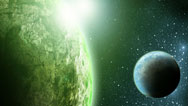Found It!
- Posted 01.01.06
- NOVA scienceNOW
In this video clip, Caltech's Mike Brown describes the eureka moment he had on the morning of January 5, 2005 when he discovered the 10th planet. The moment he realized what he was looking at, "it blew me out of my chair," he says. Brown also explains why the new body has to be larger than Pluto.
Transcript
FOUND IT!
Posted: January 1, 2006
MICHAEL BROWN (Caltech's Planetary Astronomy Group): It was morning, January 5th, 2005. I was clicking buttons and that one picture came out that just blew me out of my chair. I sat there, stared at it for a second and then grabbed my phone, called my wife, told her that I found the 10th planet.
Mostly everywhere in the sky we see things like stars and we see things like galaxies that are stationary in respect to each other in the sky. And every once in a while we see a very slow moving object going across the sky. And when we saw this one, we knew we had found something both very big and very far away. We could tell it's far away because it is moving very slowly. As we look over the sky in the course of our survey we find many, many thousands of asteroids, and they would be moving. Instead of going over the course of three hours going from here, to here, to here, they would go from here, to here, down to here, because there are so many that are moving so fast.
It has to be larger than Pluto and the way we know that is because even if it's a small, bright object reflecting all of the sunlight that strikes it, to be this bright and this far away, it still has to be bigger than Pluto.
Related Links
-

10th Planet
A stunning discovery at the far reaches of our solar system raises questions about what makes a planet a planet.
-

10th Planet: Expert Q&A
Astronomer Michael Brown of Caltech answers questions about the 10th planet.
-

Asteroid
Will a doomsday rock the size of the Rose Bowl hit Earth in 2036?
-

Hunt for Alien Earths
Astronomers may be on the brink of finding Earth-like planets beyond our solar system.



